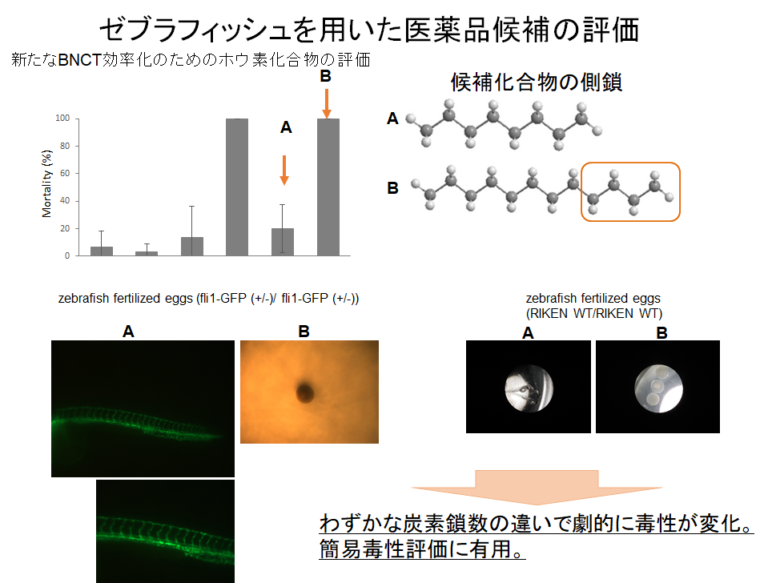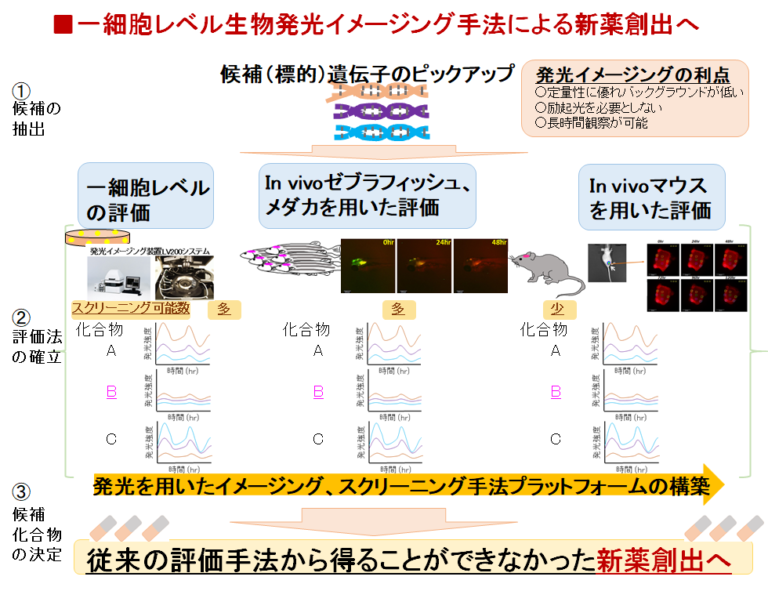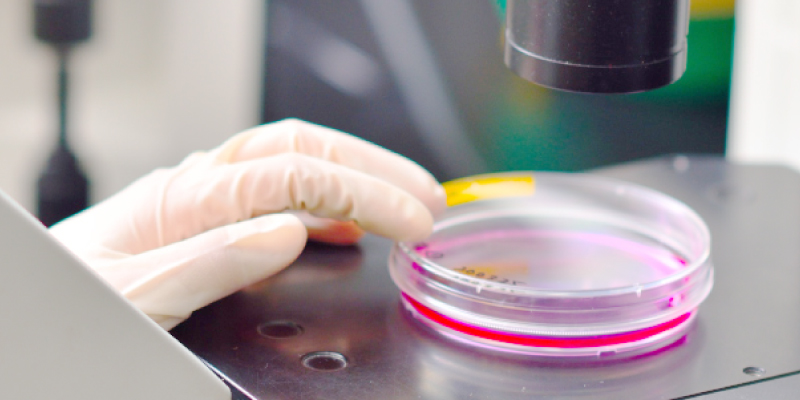メディカルバイオサイエンス学科
 堀部 智久(ほりべ・ともひさ)
堀部 智久(ほりべ・ともひさ)
Tomohisa Horibe
専門分野/分子生物学、腫瘍生物学、医薬品評価
研究キーワード/分子シャペロン、発光イメージング、薬剤評価
職位:教授
学位:博士(理学)(立命館大学)
- 立命館大学大学院理工学研究科 博士後期課程修了
- 豪州博士研究員、京都大学大学院医学研究科 特定助教、特定講師、特定准教授を経て本学へ
研究テーマ
新薬誕生までには、候補化合物のスクリーニングから、さまざまな評価および、試験(非臨床、臨床)、そして審査を経て上市されるまでに長い年月と多大な労力を要する。新たな薬剤評価系の構築は、今後の創薬に欠かすことのできない重要なステップである。一方、ホタルルシフェラーゼ(fLuc)などの生物発光は、オワンクラゲ由来のGFPと比較して、(i)低いバックグラウンドおよび高い定量性、(ii)励起光を必要としないために細胞へのダメージが低い、そして、(iii)長期観察が可能という利点を有する。当研究室では、生体物質であるタンパク質(分子シャペロン)の機能に焦点を置き、ゼブラフィッシュ、メダカなどの小型魚類および、生物発光を用いた一細胞レベルでの新たなイメージング手法による薬剤評価系の構築を以下の研究テーマを行うことで目指す。
(1) ゲノム編集技術を用いたPDI familyタンパク質のin vivo解析
生体内における機能的役割について未だ不明な点が多い、多機能性分子シャペロンであるprotein disulfide isomerase (PDI) familyタンパク質に関して、メダカおよびゼブラフィッシュを用いて、ゲノム編集技術によりノックダウンを行い、その表現型を見る。続いて、ゲノム編集技術によるfLuc-GFPのノックインを各PDI familyタンパク質に行い、発生段階、成長過程、幼魚、成魚での発現機構を解析することで、生体内における機能的役割の解明を目指す。
(2) 天然物由来ケミカルシャペロンの新たな効能、薬効の評価
食物、植物には、いくつかのシャペロン様活性、抗酸化作用を有する化合物が含まれていることが判明している。フェルラ酸(Ferulic acid)、コウジ酸(kojic acid)やルチン(rutin)などこれまで判明している活性に加え、がん細胞における新たな薬効、効果を小型魚類と生物発光を組み合わせた評価系を用いて評価することで、天然物由来の化合物をベースにした新たな創薬への可能性を探る。また、これらケミカルシャペロンを養殖用の餌に配合することでの新たな栄養素を有する魚類作出への応用可能性を探る。
(3) 小型魚類および生物発光を用いた新たな薬剤評価系およびスクリーニングプラットフォームの構築
ホタルルシフェラーゼ(fLuc)、深海エビ由来NanoLucルシフェラーゼ(NanoLuc)および、小型魚類を用いた新たな薬剤評価系および、医薬品候補化合物のスクリーニングプラットフォームの構築を行い、従来の手法では得られなかった新たな情報を得ることで、新薬創出の足がかりとなる基盤構築を目指す。


| 研究の応用領域 | 産官学連携で求めるパートナー |
|---|---|
| 医薬品の開発、新たな創薬のための新技術開発 | 医薬品・診断薬および、化粧品開発に取り組んでいる企業、養殖魚関連企業、バイオ機器メーカー、大学、国・地方自治体の基礎研究機関 |
Topics of research
It is known that the bioluminescence based on the reaction of luciferin and luciferase (Luc) has several advantages such as (i) low background and higher quantification, (ii) lower photo-toxicity since it is not necessary to use excitation light, and (iii) longer observation compared with that of green fluorescence protein (GFP). In this biomaterial science laboratory, we focus on the function of molecular chaperones in the cells, and try to establish the new evaluation methods of drug candidates using small freshwater fish such as medaka and zebrafish by bioluminescence imaging at single cell level through the research themes as described below.
(1) Functional analysis of protein disulfide isomerase family proteins in vivo by genome editing.
It is still obscure about the detailed physiological roles of protein disulfide isomerase (PDI) family proteins in vivo. Thus, we try the functional analysis of these proteins by the knock-down using genome editing in medaka and zebrafish. In addition, we try to perform the knock-in of firefly Luc-GFP by the genome editing, and evaluate the expression patterns of these proteins in the fish.
(2) Evaluation of chemical chaperones derived from natural products
It is known that several foods and plants contain compounds, which have the activities of chaperone-like and anti-oxidant in the cells such as ferulic acid, kojic acid and rutin. We try to evaluate the function of these compounds as new drug candidates in cancer cells. We also explore the application to production of aquaculture fish with new nutrients using these chemical chaperones as fish bait.
(3) Establishment of new evaluation and screening methods for drug candidates by bioluminescence imaging.
We try to establish the new platform of evaluation and screening methods for drug candidates using small fish such as medaka and zebrafish by bioluminescence imaging at single cell level, in which we use not only firefly luciferase but also small nanoLuc luciferase derived from deep sea shrimp.
主な業績論文等
- Murakami, Y., Futamata, R., Horibe, T., Ueda, K., and Kinoshita, M. (2020)
CRISPR/Cas9 nickase-mediated efficient and seamless knock-in for lethal genes in medaka fish (Oryzias latipes). Dev Growth Differ 62, 554-567. - Kohno, M., Musashi, K., Ikeda, O., H., Horibe, T., Matsumoto, A., and Kawakami, K. (2020) Oral administration of ferulic acid or ethyl ferulate attenuates retinal damage in sodium iodate-induced retinal degeneration mice. Sci Rep 10, 8688.
- Murakami, Y., Horibe, T., and Kinoshita, M. (2019) Development of an efficient bioreactor system for delivering foreign proteins secreted from liver into eggs with a vitellogenin signal in medaka Oryzias latipes. Fisheries Science 85, 677-685.
- Kurihara, R., Horibe, T., Shimizu, E., Torisawa, A., Gaowa, A., Kohno, M., and Kawakami, K. (2019) A novel interleukin-13 receptor alpha 2-targeted hybrid peptide for effective glioblastoma therapy. Chem Biol Drug Des 94, 1402-1413.
- Horibe, T., Okushima, N., Torisawa, A., Akiyoshi, R., Hatta-Ohashi, Y., Suzuki, H., and Kawakami, K. (2018) Evaluation of chemical chaperones based on the monitoring of Bip promoter activity and visualization of extracellular vesicles by real time bioluminescence imaging. Luminescence 33, 249-255.
- Lam, P.Y., Newman, J., Wang, G.Y., Arima, K., Kordula, T., Ho, I., Waters, M.R., Cavenee, W.K., Sia, K.C., Endaya, B.B., Ng, W.H., Habib, A., Horibe, T.,, Aliwarga, E., and Hui, K.M. (2017) Interleukin-13 receptor alpha 2 cooperates with EGFRvIII signaling to promote glioblastoma multiforme. Nature Commun 8, 1913.






